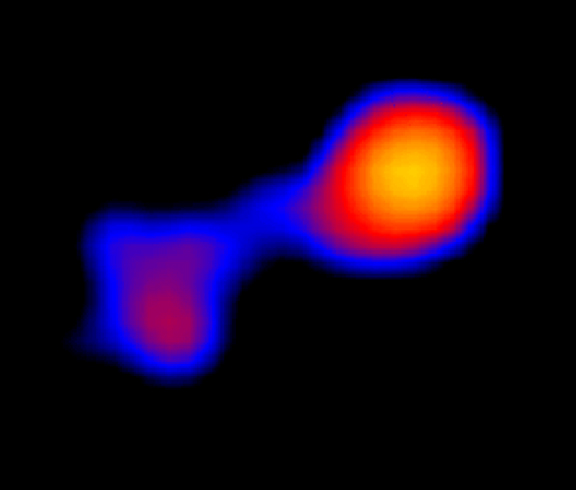
|
Credit & Copyright: X-ray Image:
M. Karovska
(Harvard-Smithsonian CfA)
et al.,
CXC /
NASA
Illustration: M.Weiss(CXC)
Explanation:
To seventeenth century astronomers,
Omicron
Ceti or
Mira was
known as a wonderful star - a star whose brightness could change
dramatically in the course of about 11 months.
Modern astronomers now recognize an entire class of long period
Mira-type variables as cool,
pulsating, red giant stars, 700 or so times the diameter of the Sun.
Only 420 light-years away,
red
giant Mira (Mira A, right) itself
co-orbits with a companion star, a small white dwarf (Mira B).
Mira B is surround by a disk of material drawn from the pulsating
giant and in such a double star system, the white dwarf star's
hot accretion disk
is expected to produce
some x-rays.
But this sharp,
false-color image from the Chandra Observatory also
captures the cool giant star strongly
flaring at
x-ray energies, clearly
separated from the x-ray emission of its companion's accretion disk.
Placing your cursor over the Chandra x-ray image of Mira will reveal
an artist's vision of this still wonderful
interacting binary star system.
Illustration: M.Weiss(CXC)
|
January February March April May June July August September October November December |
| |||||||||||||||||||||||||||||||||||||||||||||||||||||||
NASA Web Site Statements, Warnings, and Disclaimers
NASA Official: Jay Norris. Specific rights apply.
A service of: LHEA at NASA / GSFC
& Michigan Tech. U.
Based on Astronomy Picture
Of the Day
Publications with keywords: Mira - binary star - variable star - accretion disk - red giant - white dwarf
Publications with words: Mira - binary star - variable star - accretion disk - red giant - white dwarf
See also:
- APOD: 2023 December 24 Á NGC 2440: Cocoon of a New White Dwarf
- Light Echoes from V838 Mon
- The Doubly Warped World of Binary Black Holes
- APOD: 2020 August 25 Á Visualization: A Black Hole Accretion Disk
- BHB2007: A Baby Binary Star in Formation
- Animation: Spiral Disk around a Black Hole
- R Leporis: A Vampire's Star
